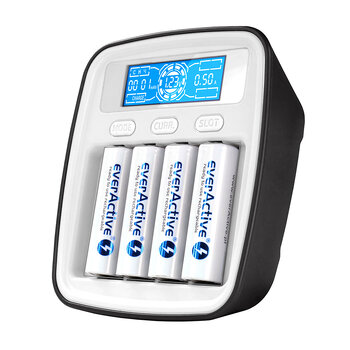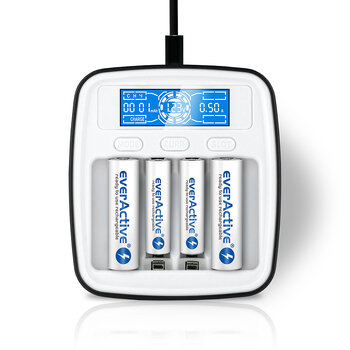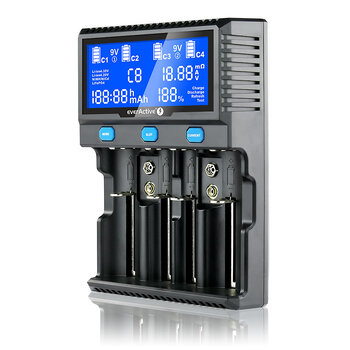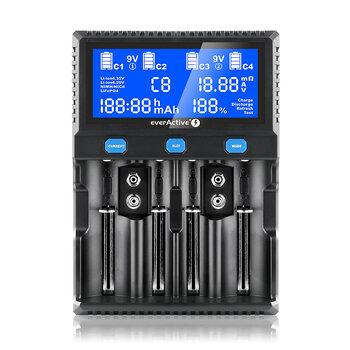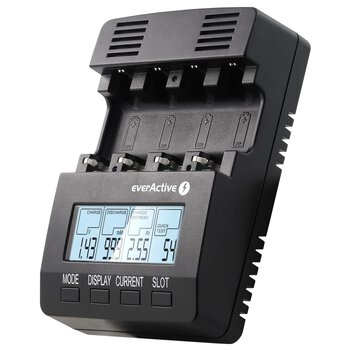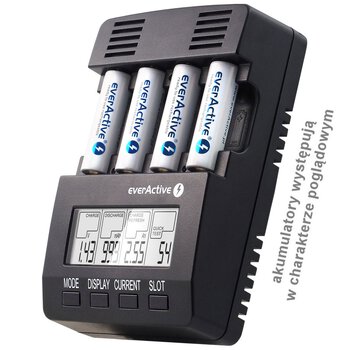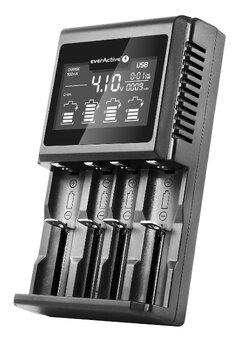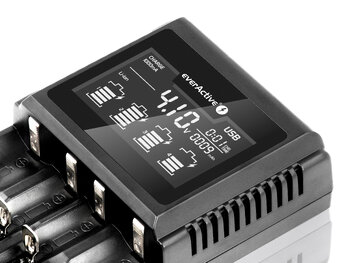- Tips
- technology
- Frequently Asked Questions
- Tests
- mAh capacity
- Rated Capacity
- everActive
- comparison
- Durability of rechargeable batteries
- Efficiency of rechargeable batteries
- battery voltage
- Accumulated energy
- Batteries vs rechargeable batteries
- LR03 AAA
- LR6 AA
- eneloop
- AG13 LR1154 LR44
- Delta V
- Charge Cycles
- internal resistance
- charge level
- CR 2032
- memory effect
- accredited test
- SR44 357
- Hearing Batteries 675
- SR626 377
- Watch Batteries
- Polarity
- Mah
- passivation
- LS 14250
- LS 14500
How long to charge rechargeable batteries and other rules for using Ni-MH rechargeable batteries
2019-05-30
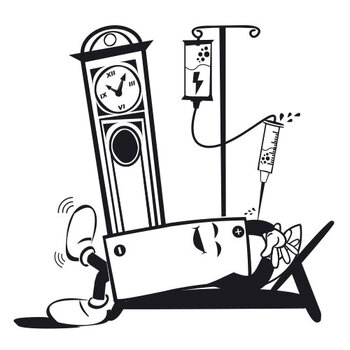
Remember that Ni-MH batteries do not particularly like:
- Extremely low discharge - even several times discharging batteries below the level of 1.0V and their subsequent storage in such a state leads to their quick and permanent destruction - you should control the level of charge of your batteries and avoid storing them completely discharged.
- Very slow discharge - using batteries for a long period of time (many months), e.g. in remote controls for audio/video equipment, leads to an increase in their internal resistance - as the resistance increases, the efficiency of energy release by the battery decreases, which in turn leads to its premature wear. Take a look at the product line dedicated to this type of device, such as Eneloop for DECT devices, or everActive Infinity Line
What has a particularly negative effect on Ni-MH batteries?
- Use and storage at extremely high (above 60 degrees C) and low (below -20 degrees C) temperatures. This leads to much faster wear.
Even if the described technology related to the use of nickel-metal hydride batteries is not completely alien to us, there is a good chance that we have not avoided a few basic mistakes that have led to faster wear of our cells. We give examples of stereotypes and check popular theses that have currently significantly lost their value:
- Is the slower we charge Ni-MH batteries, the better for their life?
This is currently a largely wrong statement, because most modern chargers for Ni-MH batteries even require a sufficiently high charging current to precisely determine the moment of full charge. The minimum value of the optimal charging current for popular AA sticks and the most capacious AAA is approx. 400 mA. Currents of 200 mA in the case of automatic chargers, controlled by a microprocessor, are optimal only for low-capacity batteries <800 mAh. - Does each time the battery is completely discharged before charging, does the battery retain its full capacity for longer?
Absolutely not - this is advice that was very valuable several years ago, when Ni-Cd (nickel-cadmium) batteries with a very visible memory effect were still widely used. This type of operation with a Ni-MH battery will lead to a significant reduction in the life of these cells. We will discuss this topic in more detail in a separate article.
So how long will it take to finally charge these batteries?
If we do not have a processor battery charger that will select the optimal charging time and current voltage for us, we must calculate the necessary charging time ourselves.Unlike car batteries, which are charged at a constant voltage, Ni-Cd and Ni-MH batteries are charged at a constant current (constant current). The simplest method of charging is simply to connect the cell to a C/10 current source for about 14-16 hours. C stands for the capacity of the battery (calculated in milliampere-hours - mAh) - let us remind you that a battery with a capacity of 1000mAh (i.e. one Ah - ampere-hours) is one that is able to provide current of 1A for an hour (or current of 2A for half an hour, 500mA for two hours, etc.). Therefore, a completely discharged battery with a capacity of 2000mAh would, according to this method, be15 hours with 200mA current.
The described method is quite simple and safe - the charging current is so low that it does not threaten drastic side effects if the battery is kept in the charger for too long (the battery does not overheat excessively). The simplicity of the method - as well as the scheme for building a charger using it - has made this how most timer-controlled chargers work. They simply apply a constant current for a certain period of time, after which they disconnect the current (or switch to trickle charging mode, with a very small current, to prevent the battery from self-discharge). Since the charging time and current are usually set "hard", this method means that in timer-controlled chargers we should charge batteries with the capacities to which these chargers have been adapted. Unfortunately, this method has a number of drawbacks - it is not very effective (it assumes significant energy losses during charging), and because we do not have any control over how much energy has actually been supplied to the battery, we do not know whether the battery has not been significantly overcharged, etc.
When to disconnect the electricity?
The method described above worked well at a time when all rechargeable batteries had more or less the same, small capacity. Nowadays, with the development of all kinds of portable equipment, more and more capacious rechargeable batteries (e.g. Panasonic 2500 mAh) have also been created - which, charged in a traditional way, would simply not use all their capacity. To remedy this problem (and, as we will see, speed up the charging process without negative effects on the life of the batteries), processor chargers were invented.The basic question that the charger must "answer" is - "when is the battery fully charged?" Unfortunately, getting an answer is not easy at all. As we have seen, the "by eye" method can be used here - the battery has more or less this capacity, if we charge it for about that amount of time, it should not overcharge too much. Let's consider other possibilities – to start, let's look at the voltage changes of a single cell being charged during the charging process.
The voltage on the charged battery does not depend linearly on the level of its charge (by the way - it causes serious problems when, for example, we want to find out how much our battery is discharged - the voltage for 10% of the capacity is almost identical to that for 60%). Fortunately, however, at the end of charging, the voltage begins to increase quite rapidly (this increase, however, is much smaller in the case of Ni-MH batteries compared to older Ni-Cd batteries) - only to gently decrease when the battery is fully charged. Therefore, in order to determine when to stop charging the battery (or better - when to switch to trickle charging) it is "enough" to monitor the voltage on the cell being charged - and disconnect the current when it starts to drop. The solution seems perfect! Unfortunately, there is one problem - the voltage drop is not too high (it depends proportionally on the value of the charging current) - it is usually about 10mV for a Ni-Cd cell, and about 2-3mV for a Ni-MH cell. Measuring such a small voltage difference (additionally of an uncertain size - let's take into account the different designs of batteries, their operating history, external interference) is not an easy task - this is what you need this "processor" in processor chargers for!
Of course, it is difficult to believe such an uncertain measurement as the only source of knowledge about when to stop charging. Therefore, charger manufacturers also looked at the temperature characteristics of the cell during the charging process.
As the charging progresses, the temperature of the charged cell also increases - and in addition, the plotted characteristic is slightly more linear than the one we dealt with in the case of voltage. This is also the characteristic that better processor chargers are used to determine the moment of charging completion - the current can be cut off both on the basis of an increase in temperature above a certain threshold and when the temperature exceeds a certain thresholdtemperature (the speed at which it rises, measured in degrees Celsius per unit time) of a certain limit. You should also never forget about the good old clock mechanism "just in case" - disconnecting the charging current if it drags on too much.
How to charge batteries faster?
The answer to this question is simple - charge with more current! Unfortunately, we will quickly find out that even at currents of C/2 and higher, our cells heat up very quickly to high temperatures - which in extreme cases may even threaten to destroy the battery/leak it. Again, processors placed in chargers come to our aid - we can entrust them with controlling the charging current so that it lasts faster - without destroying our batteries. Below are some scenarios for charging runs on different chargers. Before each charge, we discharged the battery - this guarantees that charging always took place under the same conditions - from completely discharged cells. During normal operation, there is no need to discharge the Ni-MH battery each time, as this shortens its life (after all, discharging is equivalent to normal use of the battery).The patient was an everActive Silver Line AA rechargeable battery with a minimum capacity of 1900 mAh.
- 1C current charging
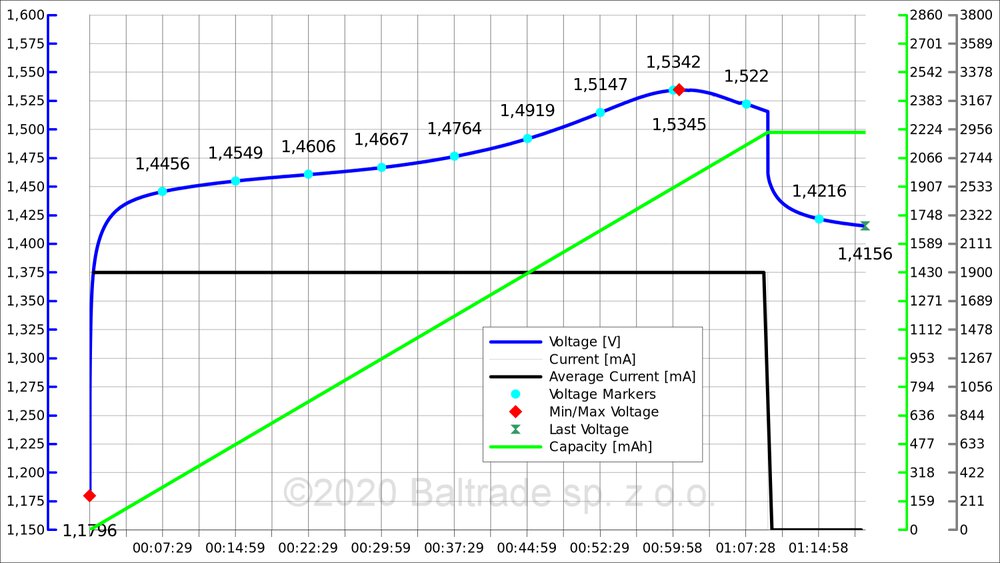
It means that the battery is fully charged in just one hour, but the cell in such conditions heats up very quickly - this phase of charging ends immediately when the speed of the cell's temperature increase exceeds 1 degree Celsius/minute, or when a voltage drop is detected on the battery in the final phase of charging - C/5 charging
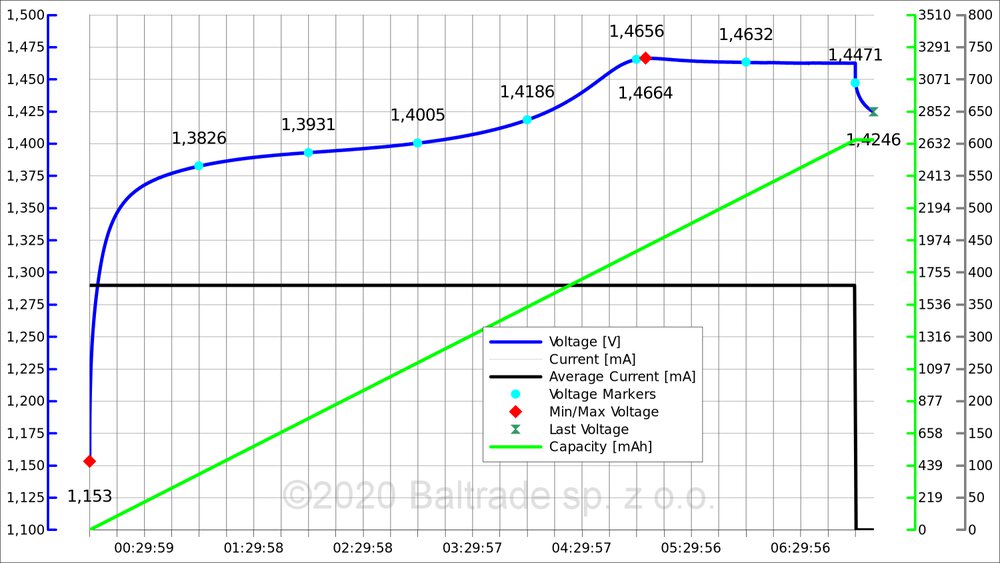
It ends when the voltage on the battery is recorded (additional criteria may also be an increase in temperature as well as charging time) - charging with current C/10 and lower
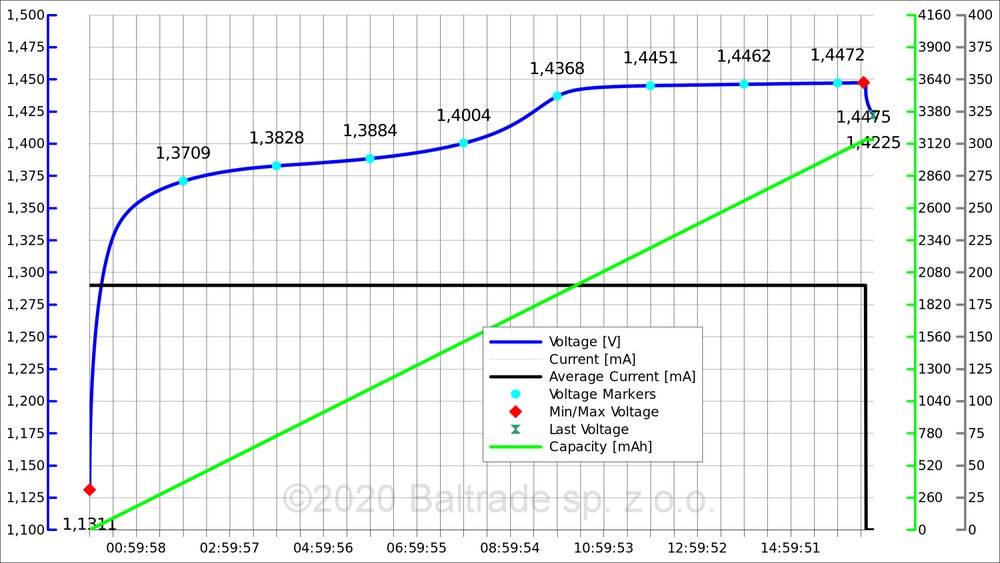
In such charging conditions, the voltage drop in the final phase of charging is completely invisible (the voltage is slowly increasing all the time), so most chargers will have a problem with correctly automatically detecting the full charge of the battery - in such conditions, the charging time should be controlled above all. This is the least efficient and simplest method of charging used in most of the cheapest chargers, often the charging ends only when the battery is removed from the charger. This method also carries the greatest risk of regular overcharging of the battery, which can result in faster wear - trickle charging with C/100 current - ending only when the battery is removed from the charger - is aimed at keeping it in a state of permanent full charge (it should be remembered that, for example, Ni-MH batteries left "on the shelf" can lose up to 3% of their charge per day (except for new generation batteries, with low self-discharge, e.g. Eneloop, which lose capacity very slowly when not used) - this means that that they can discharge completely within a month!)
We recommend chargers:
Rechargeable battery charger Ni-MH everActive NC-1000M
- modern, mobile design,
- processor with discharge and capacity measurement,
- function of refreshing, maintenance, forming batteries,
- Min. charging time of 4 batteries 2500mAh - 3h,
- processor, Ni-MH, Ni-Cd, 1-4x R6/AA, R03/AAA,
- powered from a USB Type-C socket (no power adapter included)
16,00 € brutto
16,00 € netto
everActive UC-4200 charger for Li-ion, Li-FePO4, Li-HV, Ni-MH and 9V cylindrical batteries
- professional, universal processor charger for Li-ion, Li-FePO4, Li-HV, Ni-MH and 6F22/9V cells,
- function of discharging, refreshing and testing cells,
- large and legible display with backlight,
- supported sizes: R6 AA, R03 AAA, R14 C, SC, R20 D, 10440, 14500, 14650, 17500, 17670, 18350, 18500, 18650, 20700, 21700- also protected, 22650, 25500, 26500, 26650, 32650, 33600, 16340 R-CR123e, 6F22/9V
- charging current: from 200mA up to 2000mA for Li-ion / Li-FePO4, from 200mA to 1000mA for Ni-MH, 60/120mA for 9V,
- Very accurate charge control regardless of the battery type.
- reactivation of 0V cells
40,00 € brutto
40,00 € netto
Charger everActive NC-3000
The most advanced charger from everActive
Processor with discharge and measurement of capacitance and a unique test of internal resistanceof the cell,
function of refresh, maintenance, battery formation,
Min. Charging time 4 batteries 2500mAh-3h.
Processor, Ni-MH, Ni-Cd, 1-4x R6/AA, R03/AAA, 1-2x R14/C, R20/D using optional adapter
12V DC Input voltage-AC adaptor included, optional car adaptor available
2 years Warranty
Processor with discharge and measurement of capacitance and a unique test of internal resistanceof the cell,
function of refresh, maintenance, battery formation,
Min. Charging time 4 batteries 2500mAh-3h.
Processor, Ni-MH, Ni-Cd, 1-4x R6/AA, R03/AAA, 1-2x R14/C, R20/D using optional adapter
12V DC Input voltage-AC adaptor included, optional car adaptor available
2 years Warranty
20,00 € brutto
20,00 € netto
Charger for Li-Ion and Ni-MH rechargeable cylindrical batteries everActive UC-4000
- professional, universal microprocessor charger for Li-ion cells, Li-FePO4, Ni-MH,
- discharge and refresh function to maximize battery life,
- unique function to measure and review two capacity values for each battery after single refresh cycle - Capacity Review,
- Supported sizes: R6 AA, R03 AAA, R14 C, R20 D, 10440, 14500, 14650, 17500, 17670, 18350, 18500, 18650, 20700, 21700, 22650, 25500, 26500, 26650, 32650, 33600, 16340 R-CR123e,
- Charging current: 500 mA, 1000 mA for Li-ion/Li-FePO4, 500 mA for Ni-MH,
- very accurate and precise charging scheme regardless of battery type.
28,60 € brutto
28,60 € netto
What are the differences between rechargeable batteries and alkaline batteries?
Batteries or rechargeable batteries? The choice depends on the device!
Author: Michał Seredziński
Copying the content of the text or its part without the consent of a representative of Baltrade sp. z o.o. is prohibited. p>
Comments
number of comments: 12
Add a comment
-
Dzień dobry. Mam ładowarkę EverActive nc-1000. Ładuje w niej całkowicie rozładowane akumulatory Varta AA 2100mAh. Są one już długo używane. Prąd 500mA. Gdy są ładowane normalnie, pojemność pokazywana potrafi podskoczyć do 3000mAh. Baterie są gorące i muszę sam przerwać proces. Jeśli natomiast skieruję na ładowarkę mały wiatraczek od karty graficznej proces ładowania zawsze kończy się z wynikiem 1800 - 2000mAh. Skąd taka zależność od temperatury?
-
Skrajnie, zbyt głęboko rozładowane, mocno zależałe akumulatorki sprawiają niestety tego typu problemy podczas ładowania w ładowarkach automatycznych. Najczęściej spotykane anomalie to szybki wzrost napięcia i zakończenie ładowania po zaledwie kilku sekundach/minutach, lub właśnie znaczne "przeciągnięcie" czasu ładowania połączone z bardzo mocnym nagrzaniem akumulatora. Wzrost temperatury w sprawnym akumulatorku występuje pod koniec procesu ładowania i jest poprzedzony szybkim wzrostem napięcia - w momencie gdy akumulatorek się mocno nagrzewa napięcie powinno zauważalnie wyhamować, a nawet się obniżyć. Akumulatorek mocno "zależały" tak się nie zachowuje i ładowarka w takiej sytuacji musi polegać na innych mechanizmach bezpieczeństwa. Jeżeli te akumulatorki po kilku następujących po sobie cyklach ładowania/rozładowania nadal będą wymagała "dochładzania" z zewnątrz, to z dużym prawdopodobieństwem są już bardzo zużyte (jaki wynik pojemności uzyskujemy na nich funkcją discharge/test?) albo uszkodzone. Typowym "leżakom" pomaga kilkukrotne przeładowania i problem sam ustępuje.
Temat, gdzie sugerujemy dodatkowy nadzór przy ładowaniu zależałych, uprzednio głęboko rozładowanych akumulatorków pojawia się też w innych wpisach, np. https://www.hurt.com.pl/blog/fakty-i-mity-o-ladowaniu-akumulatorkow-ni-mh-porady-dla-uzytkownikow-akumulatorkow-ni-mh-najczestsze-pytania-i-problemy-64/page:2
-
-
Dzień dobry.
Posiadam ładowarkę PANASONIC BQ-CC55 oraz akumulatorki AA Eneloop 1900 mAh.
Problem polega na tym, że ładowarka w końcowym momencie ładowania nagrzewa akumulatorki do temperatury nawet 61 stopni Celsjusza.
Jak to ma się na trwałość ładowanych ogniw? Czy jest to bezpieczna górna granica, czy lepiej myśleć o nowej ładowarce gdzie będzie możliwość zmniejszenia prądu ładowania przez co spadła by także temperatura.
A może nie ładować takich ogniw do końca i przy zielonym wskaźniku oznaczającym 80-100% naładowania wyjmować akumulatorek?
Według producenta:
Czas ładowania: AA 2000 - 4 akumulatorki - ok. 3 godzin
Czas ładowania: AA 2000 - 2 akumulatorki - ok. 1,5 godziny
-
61 stopni to już dużo, jednokrotne nagrzanie się akumulatorków do tej temperatury krzywdy im nie zrobi, jeżeli jednak każdy proces ładowania kończy się osiągnięciem tak wysokiej temperatury to niedobrze. Oznacza to, że albo akumulatorki są wyraźnie przeładowywane w tej ładowarce, albo sama ładowarka dość mocno się nagrzewa zaburzając proces ładowania.
Pytanie też, czy te akumulatorki są względnie świeże, czy może mają już swoje lata, oraz czy taki sam efekt jest przy ładowania 2 jak również 4 szt.? Przy 2 szt. prąd jest dwukrotnie wyższy.
Generalnie, im starszy akumulator, im wyższa jest jego rezystancja wewnętrzna tym bardziej może się nam nagrzewać podczas ładowania.
W ramach eksperymentu można spróbować je naładować w ten sposób:
Naładować akumulatorek do ok. 80%, odczekać 20-30 min. aż się zupełnie ostudzi i wznowić ładowanie - takie wznowione ładowanie powinno zakończyć się dość szybko, bardziej przewidywalnie bez tak wysokiej temperatury końcowej.-
Dziękuję za odpowiedź .
Dziś zrobiłem test. 4 nowe akumulatorki ladda 1900 mAh najwyższa zanotowana temperatura pod koniec procesu ładowania 48 stopni.
Wieczorem spróbuję zrobić ładowanie 2 paluszków.
Czy ładowarka nie powinna mieć jakiegoś zabezpieczenia termicznego?-
Po kilkukrotnym naładowaniu i sprawdzeniu na nowych akumulatorkach Ladda temperatury wyglądają następująco:
AA 1900mAh 2 szt. 48 stopni
AA 1900mAh 4 szt. 46 stopni
-
Zabezpieczenia termiczne w takich niedużych ładowarkach działają zwykle dość wysoko - zwykle w zakresie 60-70 stopni C i mają za zadanie wykryć praktycznie tylko jakieś pojedyncze anomalie.
Z tych obserwacji - przy niemal identycznej temperaturze końcowej przy ładowaniu 2/4 szt. może wynikać, że sama ładowarka dość mocno się rozgrzewa (ten model ma tą samą moc na wyjściu, 2 szt. akumulatorków ładuje po prostu 2x szybciej).
Pewnie kilka stopni mniej możemy uzyskać stawiając ładowarkę np. pod kątem - np. podkładając jakieś stopki. W takiej sytuacji nie bez znaczenia będzie też temperatura otoczenia.
Inna sprawa że temp. 40-50 st. są już zdecydowanie bardziej typowe dla niedużych, szybkich ładowarek automatycznych i wyglądają już dużo lepiej jak pierwotne >60 st.
-
Czyli nie muszę się martwić? Jaka jest bezpieczna temperatura maksymalna przy której nie dochodzi do degradacji ogniw?
-
Te (i inne podobne) ładowarki tak działają i o ile nie doładowujemy akumulatorków bardzo często, to nie sądzę abyśmy odczuli jakikolwiek negatywny wpływ na żywotność posiadanych akumulatorków.
W większości kart katalogowych producenci akumulatorków Ni-MH podają temp. rzędu 60 st. jaką tą skrajną dopuszczalną, choć akumulator który przed długi okres jest narażony na taką temperaturę na pewno będzie ulegał degradacji w przyspieszonym tempie.
W praktyce, akumulator który jest mocno ciepły, ale nie parzy nas jeszcze w dłonie pod koniec ładowania jest czymś zupełnie naturalnym i prawidłowym.-
Dziękuję za wyczerpującą odpowiedź :)
Pozdrawiam
-
-
-
-
-
-
-
-
Witam mam lampy solarne lepsze nie badziewie za 10 złoty
Są w nich akumulatory Aaa 600mah czy mogę zastosować asa Panasonic eneloop 750 mAh kupiłem je okazyjnie
Będą jakieś plusy czy minusy zamontowania.
Pozdrawiam serdecznie.-
W przypadku akumulatorków AAA możemy użyć takich o nieco wyższej pojemności, choć zupełnie bez sensu byłoby użycie np. najbardziej pojemnych ~1000 mAh.
Problematyczne w tych lampkach są niewielkie panele PV, które są w stanie doładowywać akumulatorki bardzo niskim prądem i to tylko w warunkach dobrego nasłonecznienia.
Zwykle akumulatorki pracują w takich lampkach w warunkach całkowitego rozładowania i sporadycznego, niewielkiego doładowywania (akumulatorki rzadko są doładowywane powyżej 40-60%) - dlatego stosuje się w nich zazwyczaj ogniwa o niskiej pojemności, które też często charakteryzują się lepszą trwałością/żywotnością.
Niezależnie od tego jakie akumulatorki tam zainstalujemy, zalecałbym dokonywać np. raz na 2 tygodnie ich doładowania "konserwacyjnego" w standardowej, zewnętrznej ładowarce. Może to istotnie wydłużyć okres ich eksploatacji.
Białe Eneloopy stosunkowo dobrze znoszą cykliczne głębokie rozładowania, także powinny całkiem dobrze działać w takim zastosowaniu.
-
-
Witam.Mam ładowarkę GP PAWERBANK nite-lite model GPPB11GS AC230V-50Hz 10W Dla akumulatorów AA DC 2.8V---220mA Kupiłem akumulatorki DURACELL 25OOmAh AA HR6/Nimi 1.2V i zastanawiam się jak długo ładować.Z góry dziękuję za odpowiedź
-
To powolna ładowarka ładująca akumulatorki w parach. W przypadku rozładowanych akumulatorków 2500 mAh czas pełnego ładowania przy prądzie rzędu 220 mA będzie wynosił nawet ok. 16-20h. Tak
niski prąd ładowania jest stosunkowo mało szkodliwy dla akumulatorków, nawet gdy zostaną przeładowane, jednak również zbyt niski aby jakkolwiek, optymalnie i w sposób automatyczny naładować akumulatorki o nieznanym wcześniej stopniu naładowania.
Także jedyną metodą ładowania takich akumulatorków w tej ładowarce pozostaje każdorazowe, ręczne pilnowanie czasu ładowania - min. 16h i pogodzenie się z ryzykiem regularnego przeładowywania akumulatorków, które nie były uprzednio zupełnie rozładowane.
-
-
Cześć, niedawno kupilem latarke energizer hard case spotlight, ktora jest napedzana 6xAA NI-MH, ma ona funkcje ladowania akumulatorow, mam rowniez latarke czołowa napedzana 1xAA. Teraz moje pytanie czy jesli po naladowaniu tych 6 akumulatorkow zamienie jeden z nich na nienaładowany z tej latarki czolowej to czy ladujac ten jeden z pięcioma naladowanymi zmniejszam zywotnosc tych pięciu naladowanych?
-
W latarce ogniwa są ładowane w pakietach. Także warunkiem względnie poprawnego naładowania całości jest równy stopień uprzedniego rozładowania ogniw.
W przypadku próby naładowania jednego, innego akumulatora stwarzamy realne ryzyko przeładowania pozostałych akumulatorków.
Nawet ładowanie tylko 6 jednakowych akumulatorków bezpośrednio w latarce nie będzie idealne i nie zapewni optymalnej żywotności tym akumulatorkom - także być może lepszym rozwiązaniem byłoby zwyczajnie ładowanie wszystkich w niezależnej, dedykowanej ładowarce.
-
-
Cześć.
Po wyjęciu naładowanych ogniw li ion 18650 z ładowarki liitokala li-500s napięcie na nich wynosi 4,21V. Czy takie przeładowanie szkodzi ogniwom i dyskwalifikuje ładowarkę, czy mieści się w granicach błędu bez uszczerbku dla ogniw?-
4,21V zmierzone na ogniwach Li-ion po wyjęciu ich z ładowarki oznacza, że ładowarka ładowała je nawet do nieco wyższego poziomu, choć prawdopodobnie "zmieściła" się w tolerowanym 4,25V.
Osobiście w przypadku ogniw Li-ion preferuję ładowarki, gdzie po wyjęciu akumulatorka napięcie wynosi nieco poniżej 4,20V, jednak 4,21V jest nadal akceptowalne - na pewno mieści się w granicach błędu typowej ładowarki.
-
-
Witam,
Posiadam ładowarkę everActive nc900U.
Jak długo baterie mogą przebywać w ładowarce na ładowaniu podtrzymującym?
Do kolejnego użycia tj. około 2tygodnie?
Używam baterii eneloop i extreme-
Dla akumulatorków Eneloop długotrwałe ładowanie podtrzymujące w skrajnej sytuacji może doprowadzić do skrócenia żywotności akumulatorków.
Okres kilku dni nie jest problemem, jednak okres 2-tygodni może już być zbyt długi w większości ładowarek z podtrzymaniem naładowania.
-
-
Witam, posiadam jedną z lepszych ladowarke na rynku Liitokala Lii 600 gdzie można wybrał ładowanie ręcznie lub automatycznie dla NiMh można ustawić od 250 do 1000, ładowarka np dla eneloop automatycznie ustawia na 1000 i pytanie, czy te szybkie ładowanie nie skrócą życia akumulatorów? I czy też naładuje tak dokładnie jak np prądem 250 czy 500. Prosze o odpowiedź.
-
Panie Dawidzie, nie miałem w rękach modelu Lii-600, jednak wcześniejsze ładowarki tego producenta miały niemałe problemy z prawidłową obsługują akumulatorków wykonanych w technologii Ni-MH.
Automatyka dobierania prądu ładowania jest związana z pomiarem rezystancji wewnętrznej instalowanego akumulatorka - takie pomiary w tego typu ładowarkach mogą być bardzo nieprecyzyjne, co za tym idzie "automatyka" może zwyczajnie nie dobierać prądów ładowania w sposób prawidłowy.
Wracając do pytania, dla akumulatorków AA Ni-MH prądy ładowania w zakresie 500-1000 mA powinny być odpowiednie (pod warunkiem, że algorytm ładowania jest prawidłowy). Dla AAA optymalne wartości to zwykle 400-800 mA. Prąd rzędu 250 mA zostawiłbym tylko dla akumulatorków o bardzo niskiej pojemności - np. poniżej 500 mAh.-
Trochę to ładowanie prądem 250 mA tylko dla aku poniżej 500 mAh nie zgadza się z tym waszym artykułem https://www.hurt.com.pl/blog/czy-szybkie-ladowanie-szkodzi-akumulatorkom-ni-mh-jak-poprawnie-naladowac-akumulatorki-niklowo-metalowo-wodorkowe-50 gdzie za optymalne prądy autor uważa 0.2 - 0.5C czyli prąd ładowania dla aku z przeciału 700 - 1000 mhA czyli typowych AAA wychodzi właśnie w okolicach 250-300 mA. Taka sytuacja.
-
Jestem autorem obu przytoczonych artykułów - trzeba mieć na uwadze, że są one oczywiście pewnym uproszczeniem tematu i go w 100% nie wyczerpują. "Optymalnego prądu" ładowania akumulatorka Ni-MH nie da się katalogowo umieścić w ramach % pojemności dla każdego akumulatorka w każdym rozmiarze. Zależeć to będzie w większym stopniu od rozmiaru akumulatorka jak również od jego kondycji, stanu technicznego itp. Ważne aby nie był rażąco niski ani zbyt wysoki. Przy czym określenie tego zbyt niskiego prądu ładowania jest kluczowe dla prawidłowej oceny pełnego naładowania bazującej na detekcji ujemnej delty V i na nim warto się skupić.
Jak wykazaliśmy na podstawie wyników testów na typowym ogniwie AA / R6, przytoczonych w naszych artykułach, można przyjąć, że 0.2C - 0.5C będzie optymalnym prądem. Jednak w przypadku ogniw AAA ten optymalny prąd spokojnie może zostać podniesiony do 0.8C, a nawet blisko 1C. Wynika to z faktu, że typowy, dobrej jakości akumulatorek AAA ma tylko o ok. 20-40% wyższą rezystancję wewnętrzną od akumulatora AA i jego ogólne możliwości prądowe są dość zbliżone - wcale nie są ponad dwukrotnie niższe, jak wynikałoby z jego pojemności.
Podobnie w drugą stronę, dla akumulatorków C/D (R14/R2) - te akumulatorki można bezpiecznie ładować prądami nawet ok. 2-krotnie wyższymi jak AA, jednak też bez problemu naładujemy automatycznie prądem rzędu 500-1000 mA, co w przypadku akumulatora o pojemności 10000 mAh stanowi wartość zaledwie 0.05-0.1C - czyli teoretycznie poniżej optymalnych wartości wyznaczonych dla ogniw w rozmiarze AA.
To m.in. powód dla którego np. prąd 500 mA jest często uważany jako najbardziej uniwersalny dla ogniw Ni-MH, niezależnie od rozmiaru akumulatorka.
-
-
-
-
Posiadam ładowarkę NC-3000 oraz akumulatorki Eneloop AA HR-3UTG.
Coraz częściej sie zdarza, że ładowarka pokazuje "FULL" podczas gdy pojemność wskazywana jest ok 400mAh. Ładowanie trwa około 5h. Gdy przełącze na "discharge and refresh" to na koniec pojemność jest ok ale trwa to kilka dni. Akumulatorek "niby" naładowany do 400mAh zaczałem rozładowywać 200mA i już ma wskazanie 1500mAh. I teraz pytanie: Czy te 400mAh to prawidłowa wartośc czy tak naprawdę akumulatorek jest w pełni naładowany i jego pojemnośc jest wyższa tylko wskazanie zaniżone? Jesli nie ma co patrzec na to wskazanie to kiedy stwierdzieć, że ten akumulatorek już kończy żywot lub że wymaga odswieżenia?-
Wartości mAh uzyskana podczas ładowania nie są tożsame z pojemnością akumulatorka.
To tylko informacja ile mAh było potrzebne aby doładować taki akumulatorek do pełna. Wskazanie 400 mAh dla akumulatorka 2000 mAh oznacza tylko tyle, że ten akumulator był daleki od rozładowania gdy włożyliśmy go do ładowarki. Ładowarka NC-3000 potrafi zmierzyć faktyczną pojemność (z rozładowania) - służą do tego tryby Refresh, Test oraz Discharge.
Sama wartość zmierzonej pojemności nie mówi wszystkiego o jakości akumulatorka - ponieważ mowa jest tu o dość leciwych akumulatorkach Sanyo, sprawdziłbym ich rezystancję wewnętrzną (tryb Quick Test w ładowarce NC-3000) - wartości powyżej 200 będą świadczyć do istotnym zużyciu tych akumulatorków.-
Dzięki za szybką odpowiedź.
W międzyczasie poczytałem bardziej szczegółowo instrukcje i jakbym to zrobił wcześniej to bym się "głupio" nie pytał.
Przepraszam za zawracanie głowy i polecam innym najpierw przeczytać instrukcje :D
-
-
-
Chciałbym, żeby taki poziom wiedzy i zaangażowania był standardem w intetnetach.
-
Kupiłem u Was akumulatorki Eneloop 1,2 V 2000 mAh jakim prądem najlepiej ładować i ile czasu? Dodam że mam zwykłą ładowarkę która ładuje prądem 200 mA bez wyłączania automatycznego i ładowarkę procesorową która ładuje takie akumulatorki prądem 800 mA i wyłącza sama po pełny naładowaniu. Którą lepiej ładować ?
-
Dla akumulatorka 2000 mAh ładowanie natężeniem 800 mA w ładowarce mikroprocesorowej jest lepszym pomysłem jak ładowanie 200 mA w prostej ładowarce manualnej. Warto jednak sprawdzić, czy posiadana ładowarka automatyczna ma możliwość ładowania pojedynczych ogniw - powinna, aby zapewnić możliwie optymalne warunki ładowania.
-
-
treściwie i przystępnie
